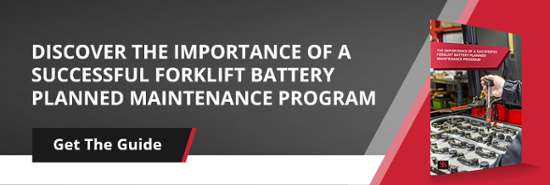If you’re overseeing material handling, a big part of the job now is “do more with less,” year after year after year. Material handling is a top-three expense for a warehouse, right after labor and lease/rental costs. That means if your C-suite is asking for a cost reduction year over year, one of the first places you must look is to your material handling fleet.
Fortunately, most material handling fleets operating 10+ forklifts on a multi-shift basis have a lot of cost reduction opportunities. That’s because, as we mentioned earlier, material handling is a large expense. And what many companies don’t realize is that the main cost when it comes to forklifts isn’t the acquisition price. In fact, maintenance and power make up 70% of a forklift’s total cost.
That’s why, whenever Concentric does an operational and power assessment (an integral part of our process), we invariably find at least a 30% cost reduction. That’s often due to a lack of usable, aggregated data and also because most maintenance programs are “pencil-whipped” (i.e., performed on paper, but not so thoroughly in real life).
If you are reading this, you might be saying--no, our team executes preventative maintenance! We have a preventative maintenance (PM) contract in place. If so, do you know the number of service events between PMs? Do your PM results drive pre-emptive repairs or parts upgrades?
To be blunt, if you don’t already have preventative maintenance optimized--and most facilities don’t--there’s no point in transitioning to predictive maintenance. In this blog, we’ll outline the first phase in the two-phase roadmap we’d recommend to move you in the right direction. (Stay tuned for phase two in our next blog, where we focus on specifics to help you establish a successful predictive maintenance program.)
PHASE 1: THE 3 STEPS TO OPTIMIZE PREVENTATIVE MAINTENANCE
1. Leverage data - Telematics data has been around for years--as has asset cost data. The former is typically siloed in a particular brand’s telematics package, and the latter is usually not available in a cloud format. Only recently have companies started marrying cost and usage data together at scale. Some of the largest material handling users may build their own internal systems, but the majority of customers will choose to either buy, set up, and manage their own system via a major telematics vendor or outsource. If you set it up yourself, make sure there is an onsite leader that will own the equipment, the reporting, and drive action based on it all. If you outsource, ensure you choose a partner that will come with data-driven recommendations on an annual or, better yet, quarterly/monthly basis.
Here’s a tip: whichever path you choose, you’ll need to track preventative maintenance success and mean time between failures.
2. Implement an effective preventative maintenance program - As we mentioned earlier, even if you have a preventative maintenance program in place, you can’t just assume that it’s effective. You need to know if you have a business process in place that tracks the timing of preventative maintenance.
3. Change your maintenance culture - Another key--and often overlooked--element for a successful program is technicians who “buy into” preventative maintenance. After all, most technicians get an adrenaline hit by fixing a piece of equipment, as opposed to preventing breakdowns. They like to fix things and problem-solve. And that’s a great trait, but in an effective preventative maintenance program, that energy is better directed toward--you guessed it--prevention. This requires a cultural change where technicians receive accolades for preventing downtime versus fixing equipment.
Train techs to start each day by looking at asset-level data, or better yet, a data-driven “to do” list BEFORE they start working on material handling equipment based solely on their instincts and whatever lift happens to be in front of them. Then, when you do shift to predictive maintenance, technicians will be able to use the best of their knowledge and data-driven algorithms and AI to drive higher uptime and lower costs for a fleet of forklifts.
Obviously, if you still need to implement any of these three steps, you still have some pretty heavy lifting to do in order to optimize your preventative maintenance program. That said, remember that factoid we mentioned earlier--that power and maintenance are 70% of the total cost of a forklift? If you’re looking to cut costs--and what company isn’t--forklift power is an often-overlooked source of savings.
And if you’re one of the rare companies that has perfected your preventative maintenance, stay tuned for part two of this blog, where we’ll explain how to transition to predictive maintenance!
Content originally published on ConcentricUSA.com. Southern States Enterprises is now a Concentric LLC. Company.







